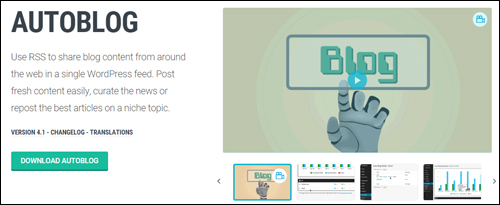 No matter what product or service you sell, providing high-value information to your site visitors is important. For example, if you provide insurance-related services, you may want to publish the latest information from government departments, such as news and updates on statistical research, insurance tips, etc.
No matter what product or service you sell, providing high-value information to your site visitors is important. For example, if you provide insurance-related services, you may want to publish the latest information from government departments, such as news and updates on statistical research, insurance tips, etc.
To create and publish this kind of information, however, is very time-consuming. You have to do a ton of data sifting, researching and organizing, fact-checking, writing and editing content (or hire someone to do this for you), and then ensure that this information is continually up-to-date. As you can imagine, this not only involves a huge amount of work but most of the information you are dealing with is beyond your control.
Thankfully, there is a much easier way to keep your site visitors up-to-date with the latest information.
It’s called RSS …
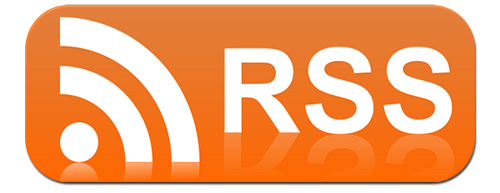
(RSS - The easiest way to provide your site readers with the latest information)
The Ultimate Guide To WordPress RSS
RSS Made Simple
- RSS, which, according to some definitions is an acronym for RDF Site Summary, is more commonly known now as Really Simple Syndication. It it is also called a “feed” or “web feed”.
- After users subscribe to a website’s feed, they no longer have to physically visit and check the website for content updates. Instead, their web browser will constantly monitor the site and automatically keep subscribers updated.
- RSS feeds are typically used to publish frequently updated information, such as new blog posts, news headlines, audios, etc., which any user can choose to subscribe to.
- RSS feeds can be viewed using a software-based tool called an RSS reader, or feed aggregator. Feedreaders can be used to access content on all kinds of topics and distribute this content (and updates made to the content) online.
- There are different feed formats and these can be read by different feedreaders. Some of these include RSS feeds, Atom Publishing Protocol) feeds and RDF feeds. All of these formats, however, use a standard XML file format to ensure that feeds are compatible with different devices, readers, and programs.
- Many sites and software tools also let you combine several RSS feeds to receive news and updates sourced from various sites.
In this detailed guide, you are going to learn where your RSS feed is located, how to use your WordPress RSS feed to get your content syndicated online, and how to add content from other websites and blogs to your site via RSS feeds.
RSS (Really Simple Syndication) Feeds
Content syndication is a powerful (and legitimate) way of sharing content online. RSS Feeds provide a way for online users to stay up-to-date with the latest information published on different sites.
First, let’s look at content syndication.
Many content publishing agencies rely heavily on syndication to publish content from content sources around the world.
Syndication allows most leading online newspapers to deliver readers stories on all kinds of topics from all around the planet without actually having to set up more reporters and writers all around the world …
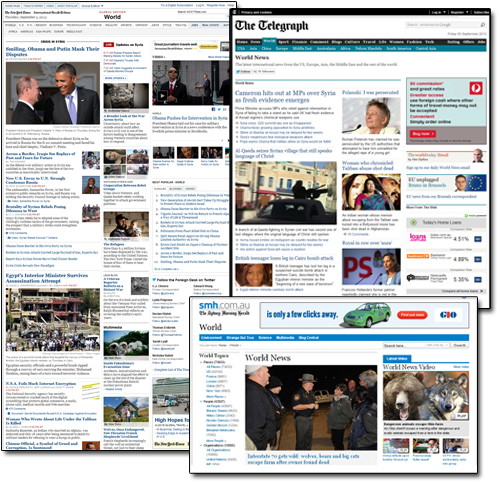
(News reporting agencies and many influential media publications use syndication to publish stories from other news agencies around the world.)
Syndication is used to share newsworthy content legitimately. Global media publications syndicate their stories using news feeds …
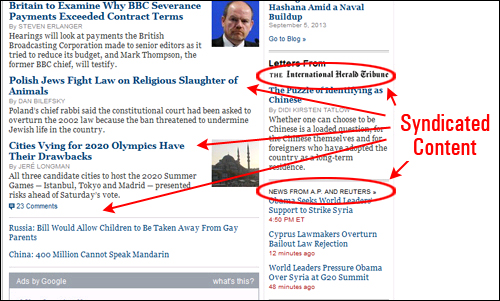
(Digital news publishing agencies syndicate news stories using feeds)
Most sites actually would like you to syndicate their information. Content syndication not only allows valuable information to be shared, but it also drives visitors back to the site that published the original content being syndicated. This creates links that can drive traffic back to their site.
Many content publishing agencies and major content sites contain an RSS feed section (look for links that say “RSS” or “Newsfeeds” in them, or just search for “name of site/keyword + rss” – e.g. “nytimes rss”, “texas tribune rss”, “sydney morning herald rss”, etc.) …
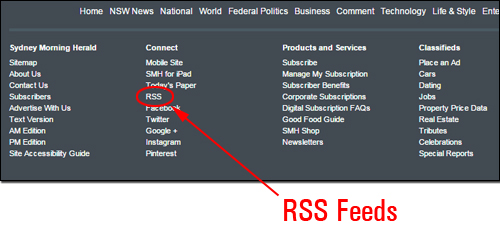
(Many online newspapers and leading online media publications include a feed section. Source: SMH RSS )
Clicking on a site’s RSS feeds section brings up a list of different RSS feed sections …
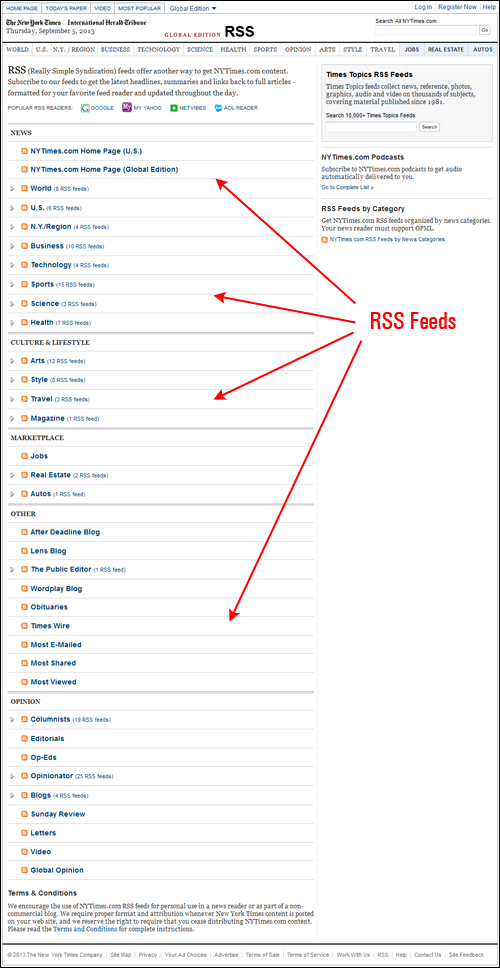
(RSS Feeds. Image: nytimes.com RSS feeds)
Each of these RSS feeds allows you to access different sections of the website (e.g. business news, entertainment news, editorials, etc.)
Feed sections can also include further feed subdirectories …
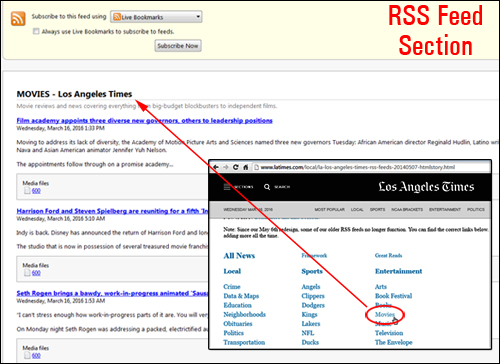
(Feed sections can also contain subcategory feeds. Source: Los Angeles Times)
![]()
Note: An RSS feed is simply a URL. All that’s required to use a feed is copy the URL and paste it into a program that can translate the feed code into something readable. We’ll cover this further below.
Using RSS Feeds – Benefits
Adding someone else’s content to your website has some obvious benefits. It helps someone else’s content and adds value to your site without you having to create the content …
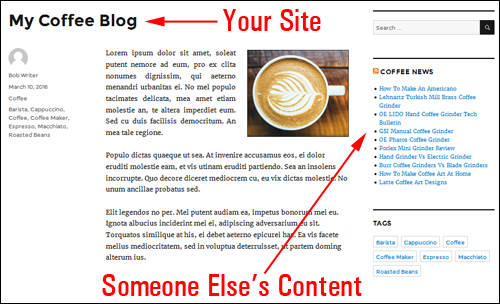
(Content Syndication Benefits Someone Else’s Business And Yours!)
While adding an RSS feed from another site is a great way to add content to your site without having to create it, it’s a great idea to try and get other sites to syndicate your content.
When other websites and blogs syndicate your content, you have the opportunity to gain more exposure online and drive more visitors …
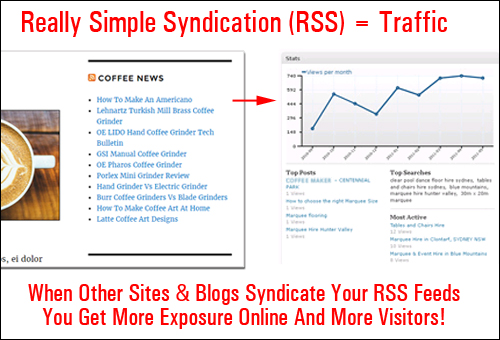
(Consider trying to get users to syndicate your content … it will help drive more traffic to your site!)
WordPress Feed – About
By default, WordPress automatically publishes a feed of your latest posts, allowing others to syndicate your content on their websites and blogs.
Depending on which theme you have installed, there are a few ways to get your RSS feed:
1) If your theme has been configured to display the Meta widget in a standard or custom menu …
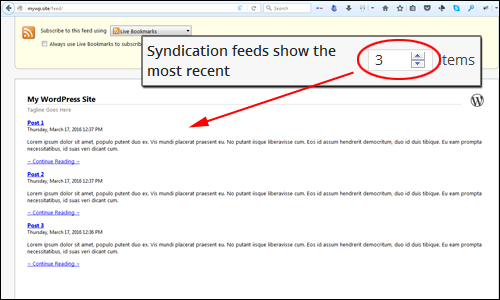
(Your feed will show the number of posts as you have specified in your Reading Settings section)
Display Full Text Or Summary Of Posts In Your RSS Feed
Another setting in the WP Reading Settings section that affects your feeds is whether to display each article as full text, or as a summary …

(WP Settings – Reading Settings – ’For each article in a feed show’: ‘Full text’ or ‘Summary’)
![]()
Post Excerpts can also affect how the content in your feed appears …
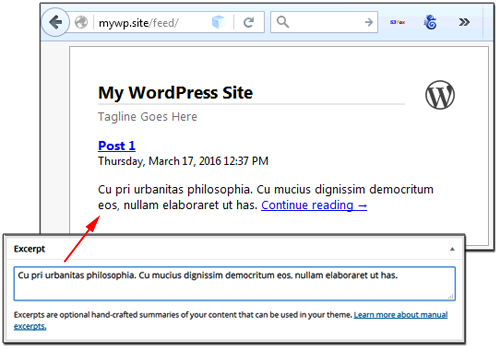
(Post excerpts can affect how a feed will appear)
To learn more about WordPress Post excerpts, refer to this step-by-step tutorial:
View The Content Of Your RSS Feeds
As mentioned earlier, to view the content of a feed, you need to copy the feed’s URL to your clipboard and paste it into an application that can read and translate feeds into readable content for humans.
Let’s take a look at how this works.
First, go to a website or blog and search for an RSS feed icon using any of the methods described earlier …
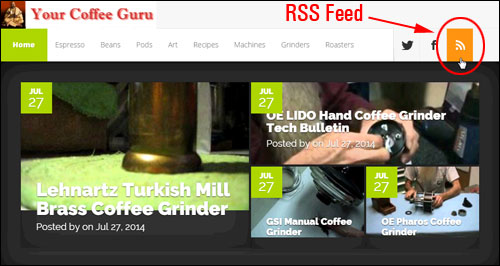
(Search for a ‘subscribe’ icon. Image source: YourCoffeeGuru.com)
Next, copy the feed URL to your clipboard …
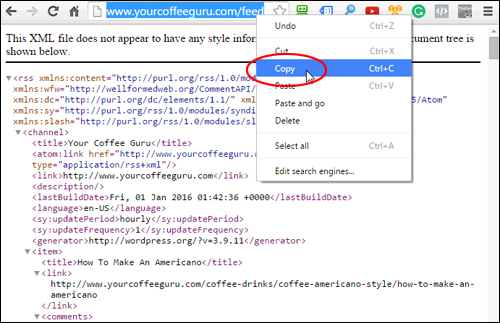
(Copy the URL of your feed to your clipboard)
If you want, you can check the feed content by pasting the URL of your feed into a feedreader …
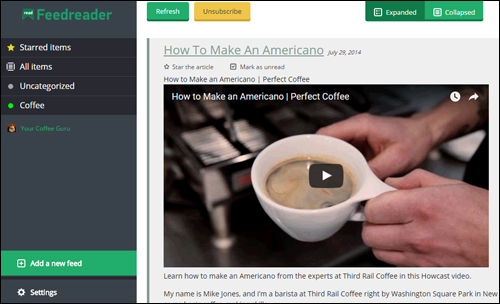
(Paste your URL of your feed into a feed reader to view the feed content. Image Source: Feedreader.com)
Like feedreaders, WordPress has the ability to process RSS feeds and convert these into readable content.
Adding RSS Feeds To WordPress Sites
In the example below, we are going to add content from other websites to yours.
How To Add Feeds To Your Sidebar
As mentioned earlier, no matter what industry your business operates in, you can add to your site the latest news and updates from an industry-related government department or authoritative site in your industry by simply importing content from their feed. You can use RSS feeds to display a range of information on your WordPress site such as news, Facebook comments, or content from thousands of sites using the WordPress RSS widget.
Let’s add RSS content to your sidebar …
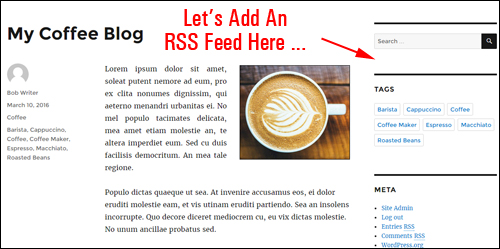
(Let’s add an RSS feed to your sidebar)
copy the RSS feed from a site containing content that you want to display on your site to your clipboard …

(Copy the URL of your feed to your clipboard)
Next, go to your Widgets area and paste the feed into an RSS widget …
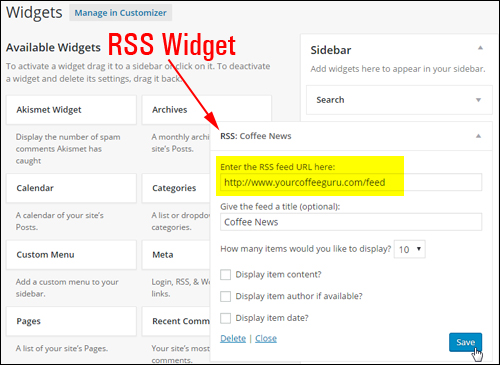
(Widgets Area – RSS Widget)
To learn more about adding content to sidebars using widgets, go here:
Load your site in your browser. The content can now be seen on your sidebar (or wherever the RSS widget has been added) …
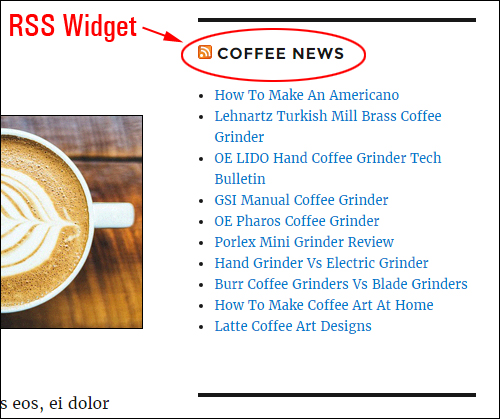
(RSS Widget)
Add Your WordPress RSS Feed To Search Consoles
You can add your WordPress RSS feed to Google and Bing’s search consoles. This will help them index your content faster.
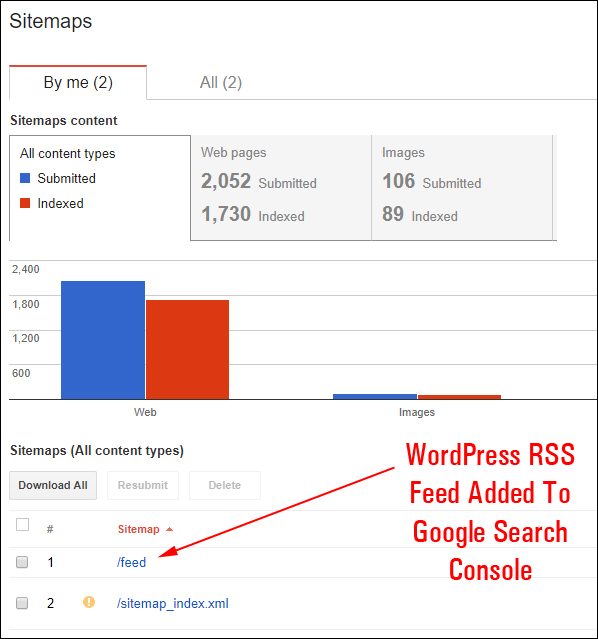
(WordPress RSS feed added to Google Search Console)
Adding your site’s RSS feed to search consoles is simple, fast, easy, and requires no technical skills. For a step-by-step tutorial, go here:
Adding RSS Feed Content To Your Posts
Can content from an RSS feed be added to a post instead of a sidebar? It sure can!
You can easily do this using WordPress plugins. Search on the WordPress plugin directory for RSS Aggregator, RSS feed to post, etc.
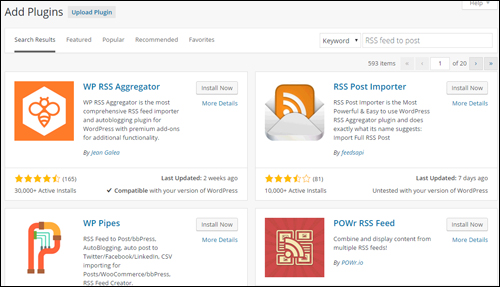
(‘Add Plugins’ search results – RSS plugins)
Note: Most RSS plugins typically require configuration – visit the plugin sites for configuration instructions, or contact us if you need assistance with plugin configuration.
Here are a few auto blogging tools that let you create posts with RSS feeds:
WPeMatico
(WPeMatico Plugin For WordPress)
WPeMatico is an autoblogging plugin that allows you to publish posts automatically from specific RSS/Atom feeds.
You can manage all the feeds you import and arrange feeds according to categories and campaigns.
For more details, go here:
WP RSS Aggregator
(WP RSS Aggregator – WordPress Plugin)
WP RSS Aggregator is an RSS feed importer and autoblogging WordPress plugin with premium add-ons for extended functionality.
For example, the Feed to Post add-on allows you to add content to your site automatically by importing RSS feeds directly into your posts or any other custom post type.
For more details, go here:
RSS Post Importer
(RSS Post Importer – WordPress Plugin)
The RSS Post Importer plugin lets you curate, syndicate, import, merge and display full-text RSS feeds on your WordPress website or blog.
RSS Post Importer will fetch an RSS feed and publish the entire content of each item in your feed as a standalone post.
For more details, go here:
Powr RSS Feed
(Powr RSS Feed – WordPress Plugin)
POWr RSS Feed lets you combine and display content from a number of different content using RSS feeds.
This plugin also lets you display videos, images, and article content, adjust feed spacing and size, use custom fonts, colors, borders, and more. It also displays feeds correctly on all phones, computers, and tablets and supports text in all languages.
The premium edition of POWr contains many additional features.
For more details, go here:
WP Pipes
(WP Pipes Plugin)
The WP Pipes plugin is a powerful data migration plugin that allows you to curate content from RSS feeds, Google News, and many other sources.
This plugin provides loads of powerful features like CSV importing for posts/WooCommerce, RSS feed creator, auto blogging, auto post to Facebook/LinkedIn/Twitter, export posts as iTunes podcasts, create Google XML sitemaps, and more!
For more details, go here:
FeedWordPress
(FeedWordPress – WordPress Plugin)
FeedWordPress provides versatile syndication options for WordPress.
As stated in the FeedWordPress website …
FeedWordPress is an open-source Atom/RSS aggregator for the WordPress blog publishing platform. You set up feeds that you choose, and FeedWordPress syndicates posts from those sources into your WordPress posts table, where they can be displayed by your WordPress templates like any other post — but with additional meta-data, so that your templates can properly attribute the post to the source it came from.
You can use this plugin to create aggregator site (sites that display content from various different sources), or bring together all of your online activity (e.g. from your blog, Twitter, YouTube, or other online services, into a Lifestream.
For more details, go here:
Autoblog by WPMUDev
(Autoblog Plugin)
Autoblog is an easy-to-use plugin that can be set-up very quickly, with no coding required and no complicated instructions. Simply copy and paste in the URL of your feed, name your feed (for admin purposes) and select the blog that you want it to post to.
For more details, go here:
RSS Includes Pages
(RSS Includes Pages WP Plugin)
Install RSS Includes Pages if you want to include pages in your RSS feed and not just posts (by default WordPress only includes posts in your RSS feed).
For more details, go here:
![]()
Using RSS Feeds – Useful Tips
Tip #1 – WP Comment RSS Feeds
In addition to giving online users access to RSS feeds of your latest posts, WordPress also makes available RSS feeds of the latest comments posted on your site.
You can access these comments by clicking on Comments RSS in your ‘Meta’ section …
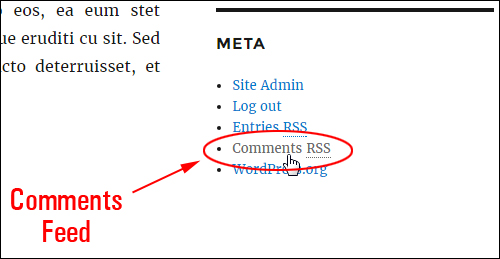
(Comments RSS)
All the comments posted on your site by visitors and users display in the Comments RSS page …
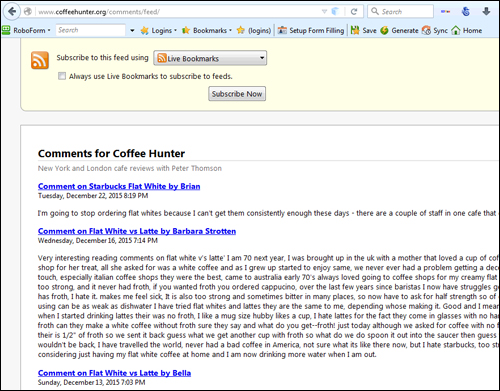
(Comments feed items viewed using a Firefox browser)
Like post entries, your comments feed page will display differently depending on the browser you use …
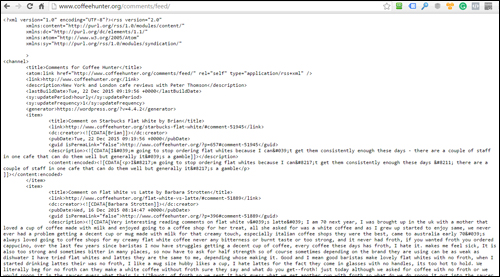
(RSS comments feed entries seen on a Google Chrome web browser)
Again, you can check what the feed contains by pasting the URL of the feed into an online feedreader …
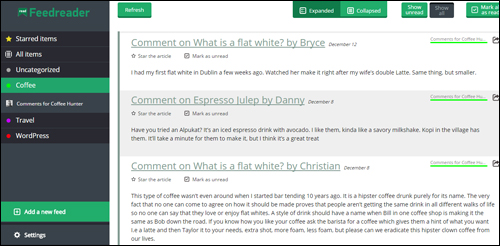
(Paste your URL of your comments feed into a feed reader to view the feed content. Image Source: http://feedreader.com/online)
Note: If the Meta section is not displaying on your theme, you can view the Comments RSS section of your site by opening up a browser and typing in the following URL:
- http://www.yourdomain.com/comments/feed
- http://www.yourdomain.com/blog/comments/feed (if your website or blog has been installed in a subdomain, e.g. “blog”)
Tip #2 – Creating Individual Item RSS Feeds
Being able to select an RSS feed for a specific post can be useful. For example, you may want to add feeds from specific items to RSS directories, or you may have created a valuable resource that other online users will want to syndicate.
The formula for displaying an RSS feed for individual posts is shown below:

(Single Post RSS Feed)
To create the above feed, copy the post address, and add “/feed/?withoutcomments=1” to the end.
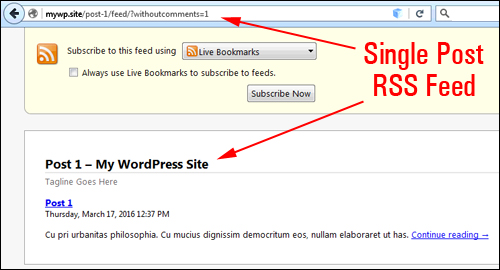
(Single Post RSS Feed)
Note: By default, if you only append “/feed” to the end of the web address of your post, WordPress will return the comments for your post, not the post content itself.
Tip #3 – Post Category Feeds
Some your site users may only be interested in subscribing to content from specific categories. They may not want to subscribe to your entire site’s feed.
If your website or blog contains content published under different categories, you can provide a separate RSS feed for each post category.
Just use the format below:

(WP post categories RSS feed format)
Select and copy the category URL …
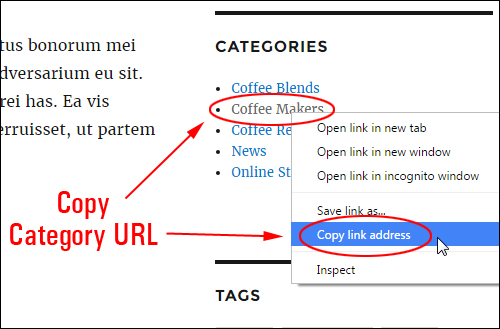
(Copy the selected category URL to your clipboard …)
Append “feed” to the end of it …

(WordPress RSS feed format for category)
Your RSS feed will now only display content specific to this particular category …
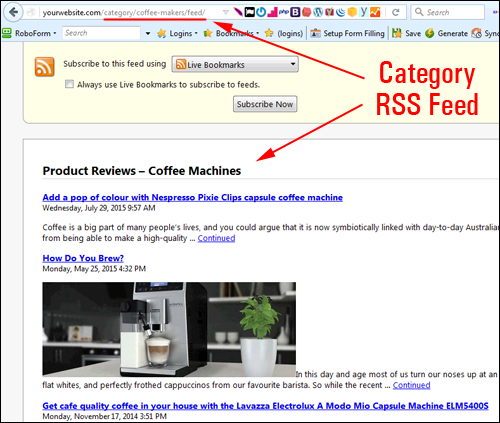
(Category-specific RSS feed page)
The WordPress Codex also provides different ways to create feeds not just for post categories, but also feeds for tags, authors, search, etc.
For this example, let’s create a feed for a specific post category using the format shown below:

(Post Category feed format. Source: WordPress Codex)
Here is the feed format WordPress recommends using. In this example, the post category ID is ’42’. We’ll need to replace the post category ID and the domain name …

(WordPress post category feed format)
To find the post category ID, go to Posts > Categories …
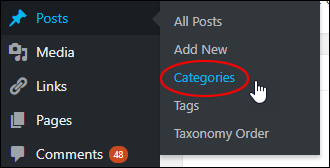
(Posts > Categories menu)
Locate the post category you want and hover your mouse over the title to reveal its unique ID …

(Post Category ID)
In our example, the post category ID is ’29’ and the post category feed format we need to use for this specific category with our domain name looks like this …

(Post category feed format with domain name and ID)
Copy and paste the feed into your browser and hit enter …
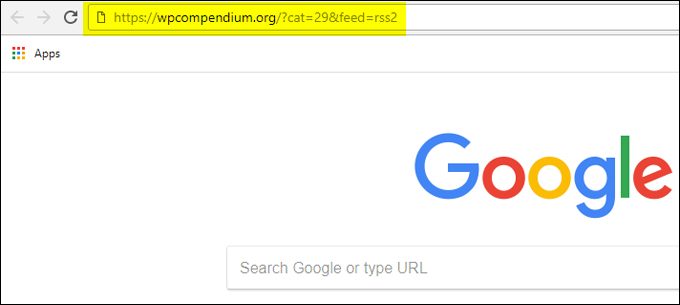
(Paste the feed into your browser)
This will display the feed for that specific category …
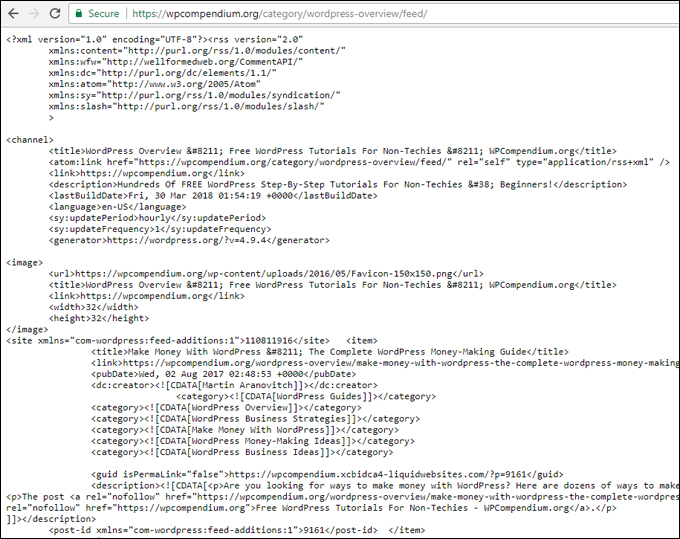
(RSS feed of a specific post category)
Note that in this example, WordPress automatically converted the feed format we pasted into the browser into the category feed we had used in the previous section of this tutorial …

(Post category feed format)
Here is the feed format again …

(Post category feed)
In this case, the simplest way to create additional feeds for specific categories is to simply change the post category slug …

(Change the post category slug to create a new category specific feed)
Paste the edited feed into your web browser and hit enter to display the content for that specific category’s feed …
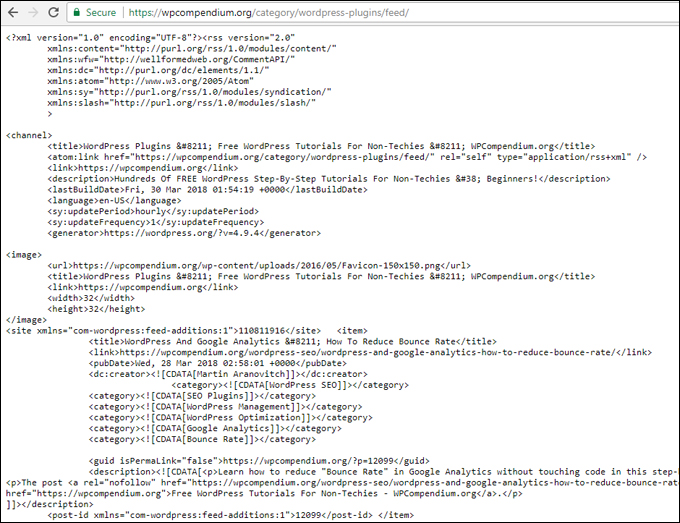
(Post category feed content)
Now that you have a method for creating feeds for specific post categories (or tags, authors, etc.), you can even create a directory or list of individual feeds for visitors.
Tip #4 – Publish A Feeds Directory
You can set up your own feeds list that allows your readers to subscribe only to specific content …
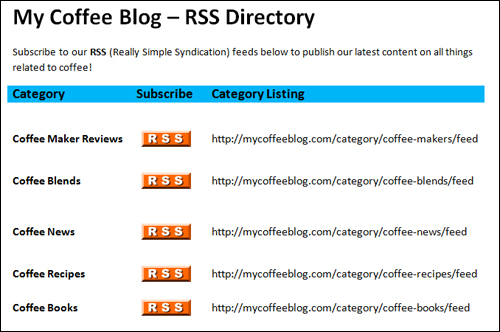
(Provide A Page Of RSS Feeds For Your Visitors)
All you need to do is link an icon to a feed URL and then create a table or a list of all feeds on a separate page …

(RSS button graphic. Image Source: public-domain-photos.com)
We have created a detailed tutorial about inserting tables into WordPress posts here:
RSS Feeds – Additional Notes
RSS feeds can be customized in several different ways, such as adding videos to feeds, ads, etc. Some of these feed customizations require editing code.
WordPress allows various RSS feed configurations that do not require editing code. Below are examples of some of the kinds of custom feed formats you can use …
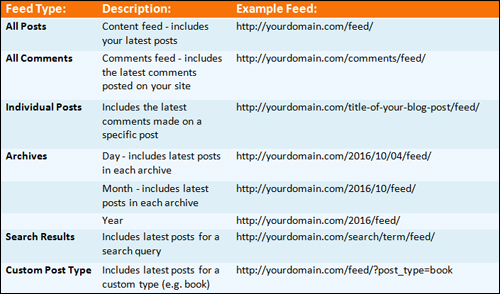
(Different Feed Formats You Can Create Using WordPress RSS)
Here are the different feed types, descriptions, and feed examples listed in the image above:
- Feed Type: All Posts
- Description: Content feed – contains your latest posts
- Example Feed: http://yourdomain.com/feed/
- Feed Type: All Comments
- Description: Comments feed – Includes the latest comments left on your site
- Example Feed: http://yourdomain.com/comments/feed/
- Feed Type: Individual Posts
- Description: Feed containing a single post
- Example Feed: http://yourdomain.com/title-of-your-blog-post/feed/
- Feed Type: Individual Posts Comments
- Description: RSS Feed that contains the latest comments made on single post entries
- Example Feed: http://yourdomain.com/blog-post-title/feed/
- Feed Type: Archives
- Description: Day – Feed that contains latest entries in each archive
- Example Feed: http://yourdomain.com/2016/03/19/feed/
- Feed Type: Archives
- Description: Month – Feed that contains latest posts in each archive
- Example Feed: http://yourdomain.com/2011/07/feed/
- Feed Type: Archives
- Description: Year – RSS feed displaying the latest items in each archive
- Example Feed: http://yourdomain.com/2012/feed/
- Feed Type: Search Results
- Description: Feed containing the latest items for a search query
- Example Feed: http://yourdomain.com/search/term/feed/
- Feed Type: Custom Post Type
- Description: RSS feed containing latest items for a custom type (e.g. book)
- Example Feed: http://yourdomain.com/feed/?post_type=book
One more thing …
It’s a good idea to promote your feed. Place your ’subscribe to RSS’ button somewhere visible …
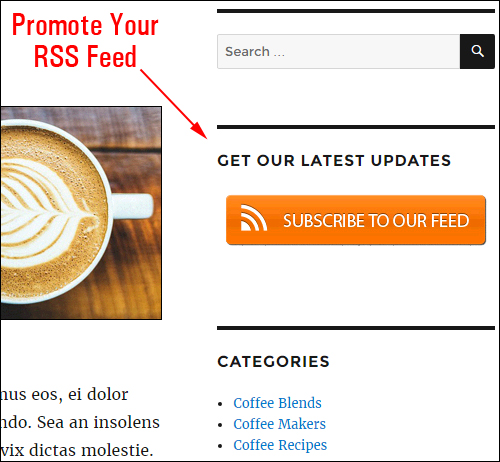
(Promote your feeds!)
Finally, keep in mind that online users will only want to syndicate your content if you provide your visitors with high-quality information that can add great value to their sites and benefit their visitors.
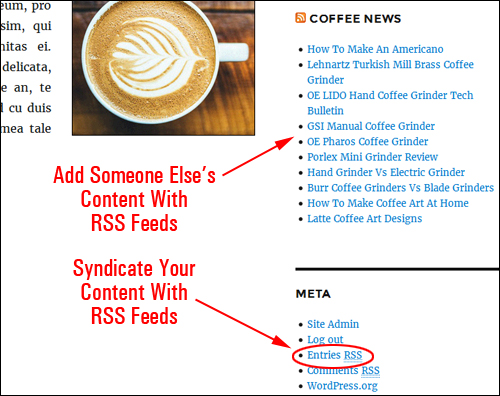
(Add great content from other sites and get visitors to share your content online using RSS!)
![]()
If you need great content ideas subscribe to our FREE content creation course using the form below:
Also, don’t forget to subscribe to our RSS feed 🙂
RSS Resources:
- Feed Icons – Visit Iconspedia.com or search online (e.g. “free RSS icons”, “rss images”, etc.) for sites that allow you to download Free RSS graphics.
- RSSBoard.org – The RSS Advisory Board Go here if you want to learn more about RSS.
- Wikipedia.org/RSS – Learn more about using RSS feeds.
- WordPress Codex – WordPress software documentation and reference repository. Go here to learn more about using WordPress RSS.
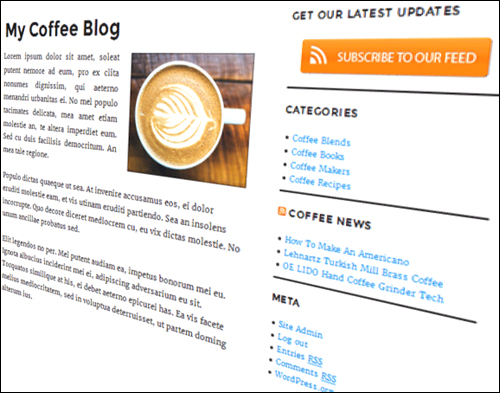
Congratulations! Now you know where to find your WordPress RSS feed, how to syndicate your content online using RSS, and how to display content from other websites and blogs on your site via RSS.
Hopefully, now you have a better understanding of issues that can affect your website and how WordPress can help you improve your business online. To read more about the benefits of using WordPress please click on links to visit other great articles and tutorials we have published on this site.
***
"I have used the tutorials to teach all of my clients and it has probably never been so easy for everyone to learn WordPress ... Now I don't need to buy all these very expensive video courses that often don't deliver what they promise." - Stefan Wendt, Internet Marketing Success Group






